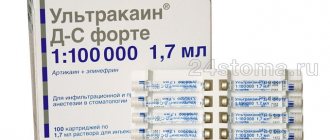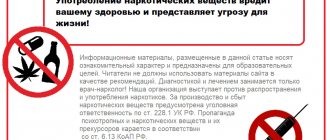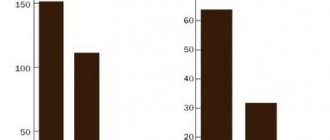From this article you will learn:
- How effective is novocaine?
- which is better - novocaine or lidocaine,
- Is it possible to dilute ceftriaxone with novocaine (or cefazolin).
The article was written by a dental surgeon with more than 19 years of experience.
Novocaine (procaine) is a local anesthetic with moderate analgesic activity that was widely used in the past for anesthesia in dentistry and general surgery. Currently, novocaine is available in the form of a 0.5 or 2% solution, in ampoules of 5 ml. In terms of the effectiveness of pain relief, it is much weaker than other anesthetics (for example, it is weaker than lidocaine - 2.5 times, and an anesthetic such as ultracaine - at least 4-5 times).
This anesthetic was previously widely used in the USSR for local anesthesia. In dentistry, it was used to remove teeth and open purulent abscesses, and in general surgery - to perform any operations under local anesthesia. Novocaine is currently not used in dentistry (it has been replaced by anesthetics based on articaine). In general surgery, novocaine is currently replaced by lidocaine - due to the greater safety and effectiveness of the latter.
Anesthetic Novocaine (in modern plastic ampoules) –
pharmachologic effect
Local anesthetic with moderate anesthetic activity and a wide range of therapeutic effects. Being a weak base, it blocks sodium channels, preventing the generation of impulses at the endings of sensory nerves and the conduction of impulses along nerve fibers. Changes the action potential in the membranes of nerve cells without a pronounced effect on the resting potential. Suppresses the conduction of not only pain, but also impulses of other modalities.
When absorbed and directly vascularly introduced into the bloodstream, it reduces the excitability of peripheral cholinergic systems, reduces the formation and release of acetylcholine from preganglionic endings (has some ganglion-blocking effect), eliminates spasm of smooth muscles, reduces the excitability of the myocardium and motor zones of the cerebral cortex.
Eliminates descending inhibitory influences of the reticular formation of the brain stem. Inhibits polysynaptic reflexes. In large doses, it can cause convulsions. It has a short anesthetic activity (the duration of infiltration anesthesia is 0.5-1 hour).
Pharmacological properties of the drug Novocain
Pharmacodynamics. Local anesthetic with moderate anesthetic activity and a wide spectrum of therapeutic action. Reduces the formation of acetylcholine and the release of norepinephrine (presynaptic effect), blocks autonomic nodes, reduces spasm of smooth muscles of internal organs, suppresses the secretion of glands of the digestive tract, dilates blood vessels, which leads to a decrease in blood pressure, myocardial excitability (antiarrhythmic effect) and nerve cells of the brain. Procaine suppresses visceral reflexes and somatic polysynaptic spinal reflexes. Pharmacokinetics. When administered parenterally, it is well absorbed. It is rapidly hydrolyzed in the blood plasma through the influence of plasma esterases and cholinesterases. The products of enzymatic hydrolysis are para-aminobenzoic acid and diethylaminoethanol. 80% of the drug is excreted in the urine. The very short effect of the drug is due to its pronounced vasoconstrictor effect and high pKa.
Pharmacokinetics
Subject to complete systemic absorption. The extent of absorption depends on the site and route of administration (especially vascularity and blood flow velocity in the area of administration) and the final dose (amount and concentration). It is rapidly hydrolyzed by plasma and liver esterases to form two main pharmacologically active metabolites: diethylaminoethanol (has a moderate vasodilator effect) and para-aminobenzoic acid (is a competitive antagonist of sulfonamide chemotherapeutic drugs and can weaken their antimicrobial effect). The half-life is 30-50 seconds, in the neonatal period - 54-114 seconds. It is excreted primarily by the kidneys in the form of metabolites; no more than 2% is excreted unchanged.
Contraindications
Hypersensitivity (including to para-aminobenzoic acid and other local anesthetic esters), children under 12 years of age. Pronounced fibrous changes in tissues (for anesthesia using the creeping infiltration method).
For epidural anesthesia: atrioventricular block, marked decrease in blood pressure, shock, infection of the lumbar puncture site, septicemia.
Carefully
Emergency operations accompanied by acute blood loss; conditions accompanied by a decrease in hepatic blood flow (for example, with chronic heart failure, liver diseases); progression of cardiovascular failure (usually due to the development of heart block and shock); inflammatory diseases or infection of the injection site; pseudocholinesterase deficiency; renal failure; children's age (from 12 to 18 years) and in elderly patients (over 65 years); weakened patients; pregnancy, childbirth, breastfeeding.
Use during pregnancy and breastfeeding
Use during pregnancy and breastfeeding is possible in cases where the expected benefit to the mother outweighs the potential risk to the fetus or child.
Novocain: reviews of anesthesia
Novocain's instructions for use, as well as my personal experience of using this anesthetic in dentistry and maxillofacial surgery, indicate the following clinical characteristics of the drug. For infiltration anesthesia on the upper jaw, the duration of “effective” anesthesia with novocaine is only about 10 minutes. With conduction anesthesia on the lower jaw, the duration of “effective” anesthesia is most often about 30 minutes.
The above figures will be correct if we work with a 2% novocaine solution without adding a vasoconstrictor solution, for example, epinephrine hydrochloride. To reduce the leaching of novocaine from the injection site (through the bloodstream), an additional 0.1% solution of epinephrine hydrochloride is added to the novocaine solution. This will slightly increase the duration of pain relief and the depth of anesthesia. Typically, 1 drop of a vasoconstrictor is added for every 2, 5 or 10 ml of novocaine - depending on the expected duration of the intervention and the somatic status of the patient.
The only advantage of anesthesia with novocaine over other anesthetics is its low toxicity. Anesthetics such as lidocaine and mepivacaine are 2 times more toxic than novocaine, and articaine is 1.5 times more toxic.
Disadvantages of novocaine –
- weak analgesic effect,
- short duration of anesthesia,
- slow onset of anesthesia,
- novocaine is a strong allergen (it ranks 4th among all drugs - the most often causing anaphylactic shock),
- has the property of lowering blood pressure (this is also why it is also advisable to use it only together with vasoconstrictors),
- Novocaine should absolutely not be used during pregnancy or breastfeeding,
- lack of analgesic effect in inflamed tissues (at the site of inflammation there is always an acidic pH, at which the effectiveness of novocaine sharply decreases, and this does not allow achieving good pain relief for purulent inflammation).
Novocain: price and release forms
Novocaine ampoules can contain either a 0.5% solution or a 2% solution. The cost of 1 package of novocaine (10 ampoules of 5 ml each) will be about 50 rubles. The modern form of release of Novocain is in special plastic ampoules, which replaced glass ones. Such ampoules are much safer when opened, and in addition, it is much more convenient to draw anesthetic from them into a syringe (this can be done without a needle).
Needle-free set of novocaine into a syringe (diagram):
Adverse reactions to anesthesia with Novocaine:
Novocaine can cause headache, dizziness, drowsiness, as well as weakness and trismus. From the cardiovascular system, possible decreases (more often) or increases (less often) in blood pressure, peripheral vasodilation, bradycardia, as well as collapse, arrhythmias and chest pain. On the part of the hematopoietic organs, methemoglobinemia is possible.
Allergic reactions: skin rash and itching, as well as urticaria (on the skin and mucous membranes), may occur. Anaphylactic reactions, including anaphylactic shock, may occur. The high frequency of side effects of novocaine is associated, among other things, with its low connection with blood plasma proteins when the anesthetic solution enters the bloodstream. For example, the binding of novocaine to blood plasma proteins is only about 5-7% - compared to lidocaine, this figure is 65%, and articaine is 95%.
Important: please note that novocaine is contraindicated for use in children under 12 years of age, as well as in pregnant women. The use of novocaine in women during lactation always requires temporary cessation of breastfeeding. The use of the drug at the age of 12 to 18 years, as well as in elderly patients over 65 years of age, is possible, but with great caution.
special instructions
Patients require monitoring of the functions of the cardiovascular, respiratory and central nervous systems. Monoamine oxidase inhibitors should be discontinued 10 days before local anesthetic administration.
Before use, it is recommended to carry out tests to determine individual sensitivity to the drug. It must be taken into account that when performing local anesthesia using the same total dose, the toxicity of procaine is higher, the more concentrated the solution is used.
Impact on the ability to drive vehicles and operate machinery
During the treatment period, it is necessary to refrain from driving vehicles and engaging in potentially hazardous activities that require increased concentration and speed of psychomotor reactions.
Directions for use and doses
For infiltration anesthesia, 0.25 - 0.5% solutions are used; anesthesia according to the method of A.V. Vishnevsky (tight creeping infiltration) - 0.125 - 0.25% solutions. For local anesthesia, to reduce absorption and increase the duration of action, add a 0.1% solution of adrenaline hydrochloride to the novocaine solution at the rate of 1 drop per 2 - 5 - 10 ml of novocaine solution. With perinephric blockade according to the method of A.V. Vishnevsky, 50 - 80 ml of a 0.5% solution or 100 - 150 ml of a 0.25% solution of novocaine are injected into the perinephric tissue. To carry out circulatory and paravertebral blockades for eczema, neurodermatitis, sciatica, a 0.25 - 0.5% solution of novocaine is administered. Intravenously administered from 1 peripheral vessels and improve microcirculation during frostbite, a mixture consisting of up to 10 - 15 ml of 0.25 - 0.5% solution is used; administered slowly, preferably in an isotonic sodium chloride solution. The number of injections (sometimes up to 10 - 20) depends on the severity of the disease. Higher doses: for intramuscular administration 0.1 g (5 ml of 2% solution), (20 ml of 0.5% solution); for intravenous administration - 0.05 g (20 ml of 0.25% solution). For infiltration anesthesia, the following highest doses are established: the first single dose at the beginning of the operation is no more than 1.25 g when using a 0.25% solution (500 ml) and 0.75 g when using a 0.5% solution (150 ml). Subsequently, during each hour of surgery - no more than 2.5 g when using a 0.25% solution (1000 ml) and 2 g when using a 0.5% solution (400 ml). To relieve spasms from 10 ml of a 0.25% solution of novocaine, 2 ml of a 2% solution of papaverine, 2 ml of a 1% solution of nicotinic acid and 10,000 units of heparin. It is administered intra-arterially slowly.
Modern analogues of novocaine in dentistry -
Lidocaine replaced novocaine around the 90s. Lidocaine is 2.5 times stronger than novocaine in terms of depth of anesthesia and duration of effect, and it does not lose effectiveness when administered in the area of inflammation (for example, with purulent abscesses). Lidocaine also has a much lower incidence of side effects. But as we said above, in dentistry lidocaine is now used only in provincial medical institutions, because In terms of depth and duration of anesthesia, lidocaine is 2-3 times inferior to articaine preparations (for example, ultracaine).
Lidocaine 2% solution in ampoules of 2 ml –
And although lidocaine is now practically not used in dentistry, in general surgery it is still one of the most widely used local anesthetics (24stoma.ru). The most popular anesthetics in dentistry today are drugs based on articaine (for example, ultracaine, ubistezin, septanest and others). For dentists, these drugs are no longer produced in glass or plastic ampoules, but in special glass carpules.
Carpule syringe and anesthetic carpules –
Each capsule contains 1.7 ml of anesthetic and is ready for use (i.e. it does not need to be opened). It is completely inserted into a special carpule syringe, into which a special double-sided needle is then screwed in from the side of the syringe nose. When you press the syringe plunger, the latter presses on the movable rubber tab located in the lower part of the carpule, which causes an increase in pressure inside the carpule and leads to the release of the anesthetic solution through the needle into the tissue.
How is anesthesia performed in dentistry?
For more information about modern anesthesia in dentistry, read the article: → Pain relief in dentistry
Side effect
Headache, dizziness, drowsiness, weakness, increase or decrease in blood pressure, collapse, peripheral vasodilation, bradycardia, arrhythmia, chest pain, trismus, tremor, visual and hearing impairment, nystagmus, persistent anesthesia, hypothermia, methemoglobinemia, allergic reactions ( up to anaphylactic shock).
Overdose
Symptoms: pallor of the skin and mucous membranes, dizziness, nausea, vomiting, “cold” sweat, increased breathing, tachycardia, decreased blood pressure, even collapse, apnea, methemoglobinemia. The effect on the central nervous system is manifested by a feeling of fear, hallucinations, convulsions, and motor agitation.
Treatment: maintaining adequate pulmonary ventilation, detoxification and symptomatic therapy.
Novocaine overdose, symptoms and treatment
An overdose of novocaine causes motor agitation, collapse, nausea, vomiting, convulsions, and respiratory depression. In the postoperative period, secondary hyperemia and bleeding are possible as a result of the use of adrenergic agonists in combination with local anesthetics. Patients, as well as medical personnel, may be allergic to Novocaine. Treatment. In case of overdose, artificial respiration, inhalation of carbogen are used, in case of convulsions, short-acting barbiturates are administered intravenously, in case of collapse - intravenous drip blood replacement fluids, in case of cardiac dysfunction - appropriate resuscitation measures.
Interaction with other drugs
Strengthens the inhibitory effect on the central nervous system of general anesthesia, sleeping pills and sedatives, narcotic analgesics and tranquilizers.
Anticoagulants (ardeparin sodium, dalteparin sodium, danaparoid sodium, enoxaparin sodium, heparin sodium, warfarin) increase the risk of bleeding.
When treating the injection site of a local anesthetic with disinfectant solutions containing heavy metals, the risk of developing a local reaction in the form of pain and swelling increases.
When using local anesthetic drugs for epidural anesthesia with guanadrel, guanethidine, mecamylamine, trimethaphan camsylate, the risk of developing a sharp decrease in blood pressure and bradycardia increases.
Use with monoamine oxidase inhibitors (furazolidone, procarbazine, selegiline) increases the risk of developing a pronounced decrease in blood pressure.
Strengthens and prolongs the effect of muscle relaxants.
When procaine is prescribed together with narcotic analgesics, an additive effect is noted, which is used during epidural anesthesia, and respiratory depression increases.
Vasoconstrictors (epinephrine, methoxamine, phenylephrine) prolong the local anesthetic effect.
Procaine reduces the antimyasthenic effect of drugs, especially when used in high doses, which requires additional correction of the treatment of myasthenia gravis.
Cholinesterase inhibitors (antimyasthenic drugs, cyclophosphamide, demecaria bromide, ecothiopathy iodide, thiotepa) reduce the metabolism of procaine.
The procaine metabolite (para-aminobenzoic acid) is a sulfonamide antagonist.



